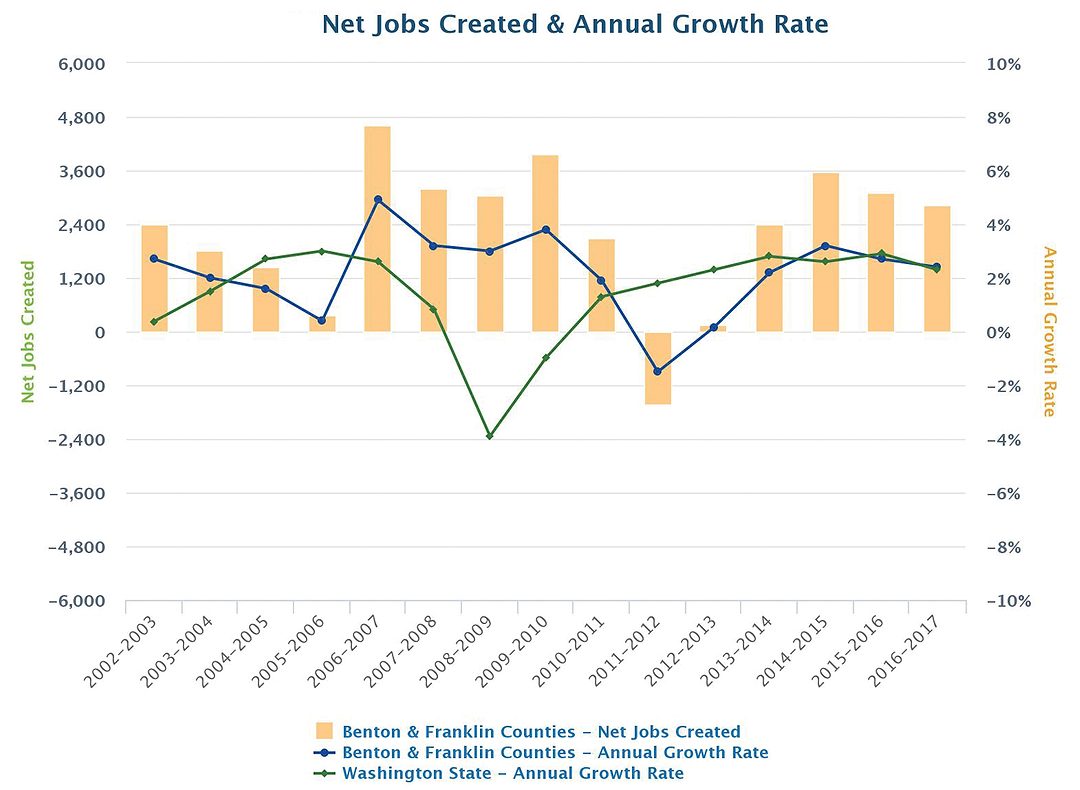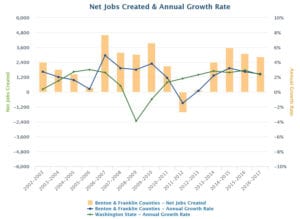
Home » Tri-City entrepreneurship, labor market show mixed signals
Tri-City entrepreneurship, labor market show mixed signals

December 13, 2018
By D. Patrick Jones
It’s human nature to keep score. Look at all the stats in the sports pages. Or the various top 10 rankings of U.S. cities. So, too, with economic development.
An overriding goal of nearly all communities is to create jobs. Chambers of commerce, local government and economic development organizations often keep score with jobs.
At least a couple of paths lead to job creation. One lies in the formation of new firms, or the activities of entrepreneurs. Another lies in the expansion of existing businesses.
How has job creation in the Tri-City area unfolded over the past few years? Quite well, as Benton-Franklin Trends data reveals. From 2013-17, the local economy generated a total net number of nearly 12,000 jobs. The implied growth rate has been nearly identical to that of our state, a unique result in Eastern Washington. The count is net because it portrays a balance of jobs gained and jobs lost; at the local level, we don’t have a way of measuring only job creation.

How have new jobs in the Tri-City area occurred? Many like to think that the gains in the job market are due to the creation of new firms. Entrepreneurship carries nearly mythical status in the U.S., as we like to celebrate the success of risk-taking and innovation. There is ample reason to hold entrepreneurs in high esteem, as innovation leads to new goods and services, which generally make us all better off.
Further, there is evidence that job growth can often be tied to a subset of young firms. These are the so-called “gazelles,” who through ingenuity, good management, and undoubtedly fortuitous timing, undergo steep expansions. (The same cannot be said for small businesses in general, which often stay small.)
It’s hard to maintain, however, that the recent jump in jobs in the Tri-City economy can be tied to entrepreneurship. Why? Over the same time period, the number of firms has, on balance, declined by about 500, out of a total number in the two counties of 8,500 in 2013. As in the net jobs indicator, the data don’t allow us to track firm “births” and firm “deaths.” All we know is the annual average, on balance.
While one might argue that new firms among the 8,000-odd total were responsible for most of the job gains, this seems unlikely. It is hard to imagine those few firms that came into being over this period adding much to the job count. That is, unless the number of firms exiting was so large that there were really many new firms “born.” Even if that unlikely scenario had played out, most gazelles don’t add significantly to their headcount during their first couple of years.
How then to explain a growing pool of people working with a shrinking pool of businesses? One explanation is simply that the “drive for size” is as present in this economy as it is across the country. Large firms and organizations have simply gotten larger. Another is that many small businesses led by boomers have “retired” along with their owners. A final one is that the entrepreneurial pulse in the Tri-Cities is weak.
But maybe not. The Census tracks a set of businesses known as “non-employers.” As the title indicates, these are companies that have no employees, yet file an IRS tax return. Nationally, they make up only 4 percent of sales. A good portion of these businesses may well be hobby enterprises. Another portion, however, might be considered the very early stage of a start-up. Think of Jeff Bezos by himself in his garage.
Local data on this class of businesses are a bit more encouraging. Over the 2013-16 period, the number grew by nearly 1,200, to a total of 12,610. Time will tell whether these businesses will graduate into firms with paid employees. For now, the Tri-Cities should celebrate recent job growth, but pay attention to its likely source.
Patrick Jones is executive director for Eastern Washington University’s Institute for Public Policy & Economic Analysis.
Local News Entrepreneur Startup Ecosystems
KEYWORDS december 2018




